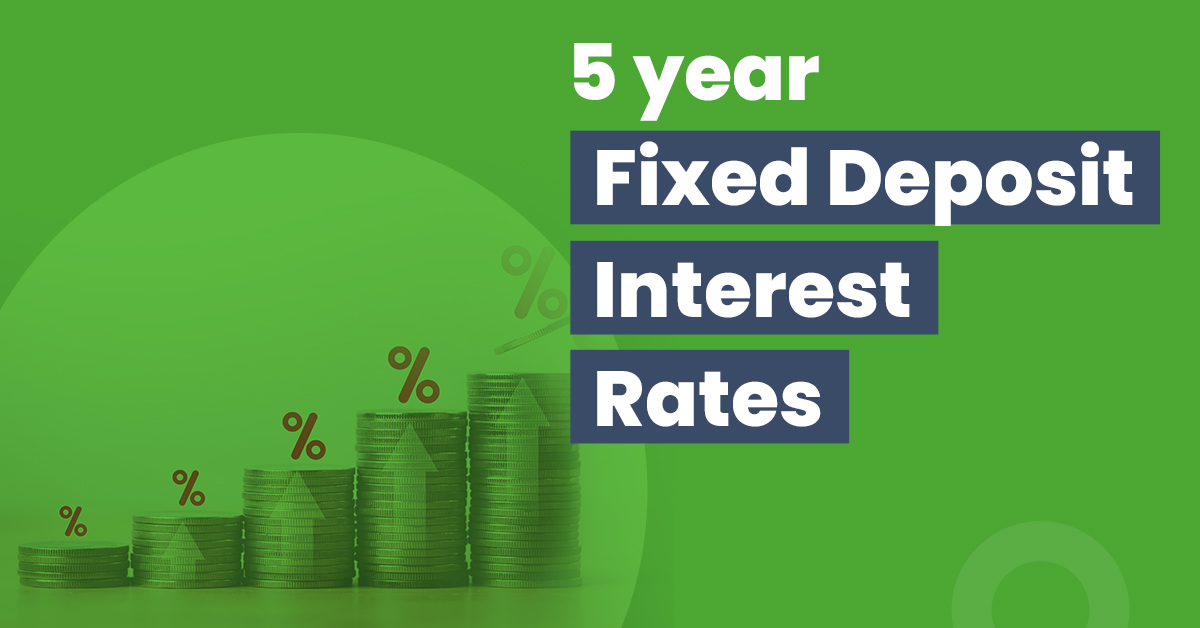5-Year FD Interest Rates in India for 2023


A Fixed Deposit (FD) is an investment instrument accessible through banks, Non-Banking Financial Companies (NBFCs) and the post office. A fixed deposit is often considered a traditional way of saving and investing. It is one of the preferred investment options for many due to its simplicity, assurance and predictability of fixed returns.
As the name suggests, FDs are investments in which you can deposit a certain amount for a certain period, and in exchange, banks guarantee a specific interest rate as a return. The interest rates depend on the amount and the tenure of fixed deposits. Generally, a term of three to five years offers favourable interest rates.
This article has a comprehensive list of banks that offer the best 5-year FD interest rates. Read further to know more.
FD Interest Rates With a 5-year Tenure
Several banks provide competitive interest rates on fixed deposits with a 5-year tenure.
IndusInd bank, for instance, offers a 6.75% interest rate, one of the highest interest rates on 5-year FDs. Senior citizens get additional interest, typically between 0.5% and 0.8%, on most bank FDs.
Consider the following factors when investing in a 5-year FD:
- Many banks offer tax-saving 5-year fixed deposits. You can avail of a deduction on the deposit amount up to Rs. 1.5 lakh under Section 80C of the IT Act.
- FD interest earned above Rs. 40,000 per financial year is subject to 10% TDS. For senior citizens, the exemption limit is Rs 50,000. If your total income for the year is less than Rs. 2.5 lakh, you can submit form 15G/15H to avoid TDS on FD interest.
- It is imperative to note that 5-year tax-saving FDs have a 5-year lock-in period. Unlike regular FD, you cannot prematurely withdraw funds or opt for a loan or credit card against it. Therefore, a regular 5-year FD may be more suitable and flexible for you if tax saving is not your primary objective.
There is also an option of choosing a cumulative or non-cumulative 5-year FD. Here are some important points on what the two types of FD mean:
- A cumulative FD allows you to reinvest the interest. You will receive the total accumulated interest and principal amount when your FD matures, and the compounded interest will provide you with higher returns.
- For instance, if you deposit Rs.1 lakh for 5 years at a 6% interest rate, you will earn a cumulative interest of Rs. 34,686. On the other hand, when you choose a non-cumulative FD, you will receive quarterly interest payments of Rs. 1,500, which will translate to Rs. 30,000 interest in five years.
- A cumulative FD with a 5-year tenure could be an attractive option if you are not looking to receive periodic interest payments.
- However, a non-cumulative FD may better suit your needs, especially if you are a senior citizen and want to receive FD interest payouts periodically. A non-cumulative FD’s interest misses out on the power of compounding, resulting in a lower return than a cumulative FD.
Also Read: Experience financial growth with unmatched Bajaj Finance FD Rates
Top Banks Offering 5-Year Fixed Deposit
The FD interest rate for a tenure of five years typically ranges from 5.30% to 6.75% per annum. Take a look at some of the top banks’ 5-year FD interest rates for deposits less than Rs. 2 crores.
| Bank | Regular FD Interest Rate | FD Interest Rate for Senior Citizens |
| SBI | 6.10% | 6.90% |
| Bank of Baroda | 6.10% | 6.90% |
| PNB | 6.10% | 6.60% |
| Post Office | 6.70% | 6.70% |
| ICICI Bank | 6.60% | 7.10% |
| HDFC Bank | 6.50% | 7.00% |
| Axis Bank | 6.50% | 7.25% |
| Kotak Bank | 6.20% | 6.70% |
| Citibank | 3.50% | 4.00% |
| IDBI Bank | 6.10% | 6.85% |
| Indian Bank | 6.40% | 6.90% |
| IDFC First Bank | 6.00% | 6.50% |
| Indian Overseas Bank | 6.40% | 6.90% |
| Bank of India | 5.75% | 6.50% |
| Canara Bank | 6.50% | 7.00% |
| Bank of Maharashtra | 5.75% | 6.25% |
| IndusInd Bank | 6.75% | 7.25% |
| Karnataka Bank | 5.75% | 6.25% |
| Union Bank of India | 6.70% | 7.20% |
| DBS Bank | 6.50% | 7.00% |
| Punjab & Sind Bank | 6.10% | 6.60% |
| South Indian Bank | 6.00% | 6.50% |
| Tamilnad Mercantile Bank | 6.00% | 6.50% |
| UCO Bank | 6.00% | 6.50% |
| Bandhan Bank | 5.60% | 6.35% |
| Dhanlaxmi Bank | 6.10% | 6.60% |
Note: Interest rates are subject to change as per the bank’s policy and the prevalent repo rate
Key Highlights
- The State Bank of India (SBI) offers a 6.10% interest rate for 5-year fixed deposits. They provide senior citizens with a higher interest rate.
- The Post Office FD offers a 6.7% interest rate for 5-year deposits.
- Among banks, IndusInd Bank offers an attractive interest rate of 6.75% on deposits less than Rs. 2 crores. The interest rate it offers on 5-year FDs for senior citizens is among the highest at 7.25%.
- The minimum FD deposit required by banks may vary; it could be as low as Rs. 1,000.
- Most banks offer tax-saving fixed deposits at the same interest rate as term deposits.
- Almost all banks offer loans or credit cards against regular fixed deposits.
Final Thoughts
The interest earned on FDs differs based on the interest rate, account type and tenure. Most banks offer competitive interest rates on 5-year FDs. Additionally, senior citizens can benefit from a higher FD interest rate.
Besides the standard 5-year FD, you can also choose tax-saving FDs, which are advantageous if tax saving is your main objective. However, remember that this variant of FDs don’t allow premature withdrawals. It is also essential to compare cumulative and non-cumulative 5-year FDs to choose the best fit for your financial needs.
FAQs
Is TDS applicable on a 5-year FD?
If the interest earned on an FD exceeds Rs. 40,000 per financial year, TDS will be deducted at 10%. However, for senior citizens, the exemption limit is Rs 50,000. If your total income in the financial year is less than Rs. 2.5 lakh, you can submit form 15G/15H to avoid TDS deduction on the FD interest.
Do banks offer higher interest rates for a longer fixed deposit term?
The interest rate for different terms varies from bank to bank. Most banks offer higher interest rates for a term of three to five years.
Can I break the 5-year tax saver FD before the completion of 5 years?
Tax saving FD has a 5-year lock-in period. Therefore, you cannot withdraw it prematurely. However, you can choose a non-cumulative fixed deposit for regular interest payouts at specified intervals.
What is the maximum investment limit for FDs?
There are no limits on regular fixed deposit accounts. However, the maximum limit for tax-saving fixed deposits is Rs. 1.5 lakh in a financial year.
Are tax-saver FDs the same as 5-year FDs?
Tax-saving fixed deposits are different from regular 5-year fixed deposits. A tax-saving fixed deposit offers a tax deduction of up to Rs. 1.5 lakh under section 80C of the Income Tax Act. However, a tax-saving fixed deposit has a 5-year lock-in period. As a result, you cannot withdraw it prematurely or avail of a loan or credit card against it. Regular fixed deposits allow premature withdrawals with a penalty.
What is the interest rate on the post office’s 5-year fixed deposit?
The post office currently offers a 6.7% interest rate on a 5-year fixed deposit.
Is the interest from tax saver FD taxable?
Yes, interest earned on the tax-saver fixed deposit is taxable. The interest is added to your gross income and taxed according to your tax slab.



